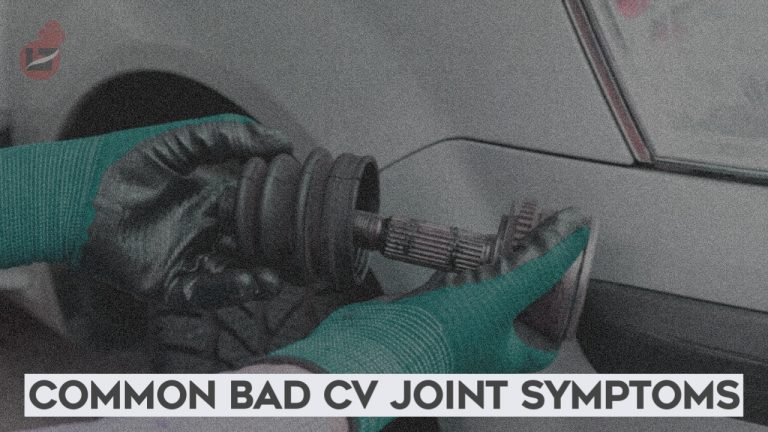This article explains the common symptoms of a failing CV joint, the risks involved, and the potential costs of fixing the problem.
CV axles play a crucial role in your vehicle’s functioning by transmitting power from the transmission to the wheels. These half-width components, also known as drive axles or half shafts, are vital to the drivetrain system.
They connect the wheel to the differential or transaxle, allowing power transfer while the wheels are in motion. A faulty CV joint can result in the entire CV axle needing replacement, making it crucial to know the signs and symptoms of a failing CV joint early on to address the issue promptly.
Common Bad CV Joint Symptoms
1. Grease Found on the Inside of Your Wheels
Finding grease on the side of your wheels is a common symptom of a damaged CV joint boot, but many drivers fail to take it seriously. The boot of the CV axle is lubricated to ensure optimal performance. The lubricating grease may leak onto your wheels if the boot sustains any damage.
While this may not be as noticeable as a clicking or knocking sound, it is an effective way to confirm CV joint symptoms and assess the health of your half shaft. Always check the inside of your tire for grease if you suspect a damaged CV boot.
2. Loud Sounds When Turning
Experiencing a loud sound while turning your car is a common indication of a faulty CV joint. If you hear popping or clicking sounds while turning your steering wheel, it could be due to a poor or malfunctioning CV joint. The extent of the joint’s damage will determine if you need to replace the entire shaft assembly and the CV joint.
3. Torn Boots
To ensure CV joints’ proper and effective functioning, they must remain lubricated and debris-free. Rubber boots cover these joints to stay lubricated, but if the boots develop a tear, dust and debris from the road may enter, causing the lubricating grease to leak out.
Drivers should regularly inspect these boots and quickly repair any tears to prevent further damage to the joint. Replacing a torn boot is also essential in protecting the CV joint. Remember, replacing a torn boot is less expensive than replacing an entire CV joint or axle!
4. Clicking While Turning
When CV joints are damaged, it can cause clicking sounds, which is abnormal since CV joints provide power while allowing the wheels to turn. The rubber boot covering the CV Axle Joint protects the joint facilitating wheel turning. If this boot is damaged, it can affect your turning ability. If you hear sudden loud clicking noises while turning, even in one direction or all directions, it could be a sign of a blown CV joint.
However, clicking sounds may also have other causes, so it’s important not to jump to conclusions and have a professional diagnose the problem.
5. Knocking sound
A knocking sound while driving is often a symptom of a problematic CV axle. However, it’s also possible that the knocking is caused by something minor. It’s essential to check for signs and address any issues immediately and thoroughly. To diagnose the problem, it’s recommended to seek the advice of a professional.
6. Bouncy Ride
If you notice that your vehicle is bouncing on a smooth, flat road, it could be a sign of a problem with your suspension, including potential issues with your CV joint. To ensure your safety and avoid further damage, it’s essential to have a mechanic inspect your suspension components, including the CV joints, as soon as possible.
7. Trouble Driving
If you hear clicking sounds while driving, avoiding forcing yourself to continue driving with a potentially bad CV joint is essential. Driving with a faulty joint can be dangerous, as it could lead to losing control of the vehicle.
This is particularly true if the joint fails while you are driving, as it can cause your vehicle to jerk suddenly to one side or the other when you accelerate.
This could increase the likelihood of an accident occurring. If you suspect your CV joint may be faulty, it is best to call for a tow truck and inspect your vehicle with a professional mechanic.
FAQs
Is a CV joint expensive to fix?
The cost of replacing a CV joint varies depending on the make and model of your vehicle and the labor costs involved. On average, the cost can range from $150 to $850. The actual CV joint can be purchased for $50 to $150, with the labor cost for the replacement ranging between $100 and $700. Remember that various factors can affect the total cost of a CV joint replacement for your vehicle.
Can you still drive with a bad CV joint?
It is essential to understand that driving with worn-out CV joints can cause them to disintegrate and make your vehicle undrivable, putting you in danger of losing control. Therefore, it is not safe to continue driving with a damaged CV joint.
As a car owner, it is crucial to be aware of any symptoms of bad or failing CV joints and take action to have them repaired before they worsen and become a safety hazard on the road.
What happens when a CV joint is bad?
When a CV joint begins to fail during driving, one wheel may lose power and cause the car to pull to one side. If the joint fails, the affected wheel will stop turning, but the engine will continue to run. However, the car will be unable to move.
As an Amazon Service LLC Program Associate, V. Auto Basics earns from qualifying purchases. See Our Affiliate disclaimer.
